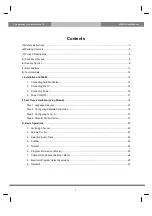
Supported Alteia Protocol Commands and Messages
2.1.3
RS-485 Connections
The RS-485 allows the controlling of multiple IRDs from a single controller, where the
devices are connected to a common cable-rail. All of the IRDs get the sent commands,
but the target receiver identifies their own command by the remote address.
The RS-485 signals are available as independent transmit and receive differential pairs
in the Remote Control Connection port. The IRD can be used therefore also in a 2-wire
(connected Tx and Rx pairs) or 4-wire (separate Tx and Rx pairs) RS-485 network.
The 2-wire cabling allows only a half-duplex communication. The 4-wire cabling allows
also the half-duplex and full-duplex communication. The duplexity mode has to be set
on the user interface corresponding to the RS-485 wiring:
Table 4
RS-485 communication modes at different wiring
Communication mode
Half
duplex
Full
duplex
RS-232
X
X
2-wire RS-485
X
-
4-wire RS-485
X
X
The chosen communication (duplexity) mode must be consistent with the wiring. If two-
wire RS485 is used, the communication mode must be set to half duplex. In the other
cases all wiring, porting and communication mode combinations can be used.
There are no handshaking signals neither in separated, nor in connected RS_485
wiring.
2.1.3.1
Wiring with separated Rx and Tx pairs (4+1 wires network)
Table 5
Pin connections with separated RS-485 wiring
PIN
RS-485 SIGNAL
IN/OUT
1
Not connected
-
2
Not connected
-
3
Not connected
-
4
RX
Input (+ve)
5
Ground
Ground
6
Not TX
Output (-ve)
7
TX
Output (+ve)
8
Not RX
Input (-ve)
9
Not connected
-
2.1.3.2
Wiring with connected Rx and Tx pairs (2+1 wires network)
Table 6
Pin connections with connected RS-485 wiring
PIN
RS-485 SIGNAL
IN/OUT
10 (59)
Document No. ST.TS.EXXXXX.1 2010-03-04











































